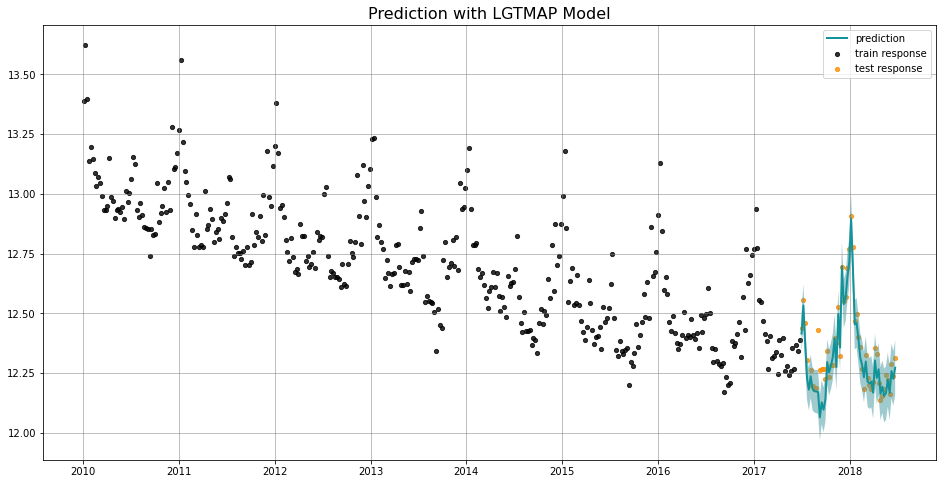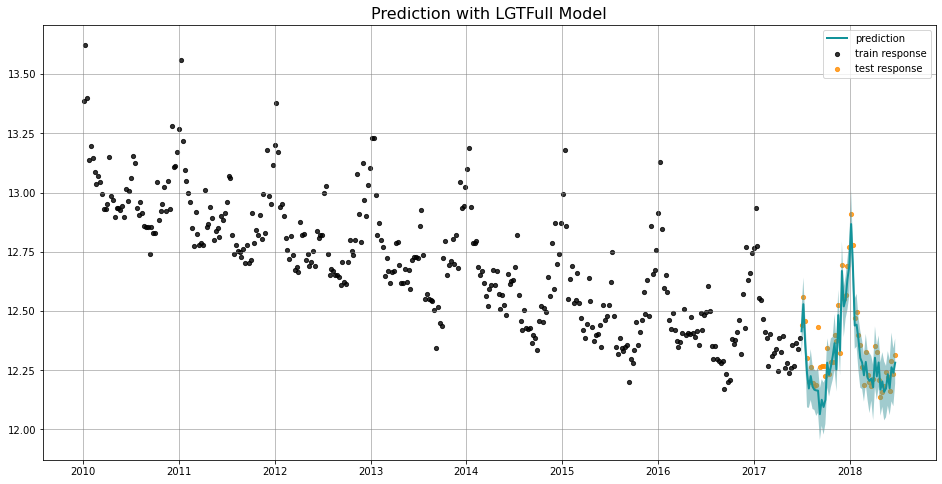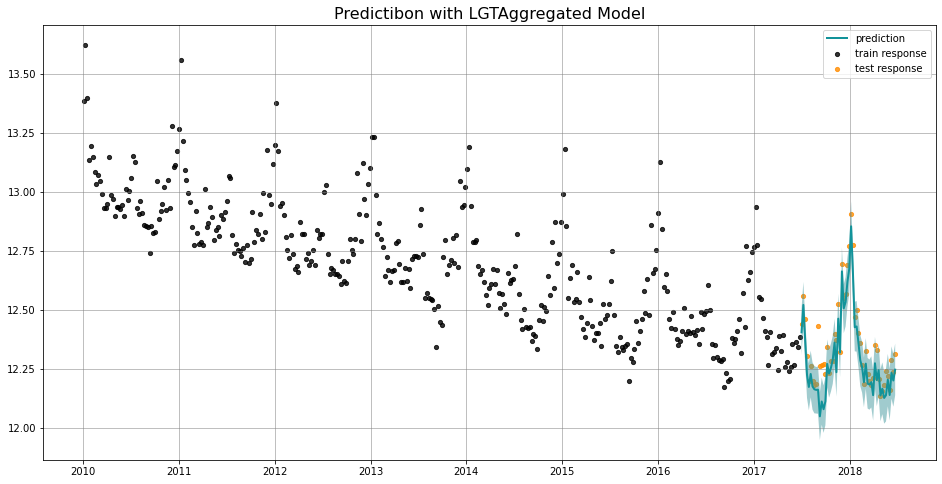Local Global Trend (LGT)¶
In this section, we will cover:
LGT model structure
difference between DLT and LGT
syntax to call LGT classes with different estimation methods
LGT stands for Local and Global Trend and is a refined model from Rlgt (Smyl et al., 2019). The main difference is that LGT is an additive form taking log-transformation response as the modeling response. This essentially converts the model into a multicplicative with some advantages (Ng and Wang et al., 2020). However, one drawback of this approach is that negative response values are not allowed due to the existence of the global trend term and because of that we start to deprecate the support of regression of this model.
[1]:
import pandas as pd
import numpy as np
from orbit.models.lgt import LGTMAP, LGTAggregated, LGTFull
from orbit.diagnostics.plot import plot_predicted_data
from orbit.diagnostics.plot import plot_predicted_components
from orbit.utils.dataset import load_iclaims
Model Structure¶
with the update process,
Unlike DLT model which has a deterministic trend, LGT introduces a hybrid trend where it consists of
local trend takes on a fraction \(\xi_1\) rather than a damped factor
global trend is with a auto-regrssive term \(\xi_2\) and a power term \(\lambda\)
We will continue to use the iclaims data with 52 weeks train-test split.
[2]:
# load data
df = load_iclaims()
# define date and response column
date_col = 'week'
response_col = 'claims'
df.dtypes
test_size = 52
train_df = df[:-test_size]
test_df = df[-test_size:]
LGT Model¶
In orbit, we have three types of LGT models, LGTMAP, LGTAggregated and LGTFull. Orbit follows a sklearn style model API. We can create an instance of the Orbit class and then call its fit and predict methods.
LGTMAP¶
LGTMAP is the model class for MAP (Maximum a Posteriori) estimation.
[3]:
lgt = LGTMAP(
response_col=response_col,
date_col=date_col,
seasonality=52,
seed=8888,
)
[4]:
%%time
lgt.fit(df=train_df)
INFO:pystan:COMPILING THE C++ CODE FOR MODEL anon_model_2af9ff5e07f97061bbe4badb0f8a2e36 NOW.
CPU times: user 1.39 s, sys: 87.2 ms, total: 1.48 s
Wall time: 55.5 s
[5]:
predicted_df = lgt.predict(df=test_df)
[6]:
_ = plot_predicted_data(training_actual_df=train_df, predicted_df=predicted_df,
date_col=date_col, actual_col=response_col,
test_actual_df=test_df, title='Prediction with LGTMAP Model')

LGTFull¶
LGTFull is the model class for full Bayesian prediction. In full Bayesian prediction, the prediction will be conducted once for each parameter posterior sample, and the final prediction results are aggregated. Prediction will always return the median (aka 50th percentile) along with any additional percentiles that are provided.
[7]:
lgt = LGTFull(
response_col=response_col,
date_col=date_col,
seasonality=52,
seed=8888,
)
[8]:
%%time
lgt.fit(df=train_df)
WARNING:pystan:Maximum (flat) parameter count (1000) exceeded: skipping diagnostic tests for n_eff and Rhat.
To run all diagnostics call pystan.check_hmc_diagnostics(fit)
WARNING:pystan:1 of 100 iterations ended with a divergence (1 %).
WARNING:pystan:Try running with adapt_delta larger than 0.8 to remove the divergences.
CPU times: user 62.4 ms, sys: 63.5 ms, total: 126 ms
Wall time: 6.16 s
[9]:
predicted_df = lgt.predict(df=test_df)
[10]:
predicted_df.tail(5)
[10]:
| week | prediction_5 | prediction | prediction_95 | |
|---|---|---|---|---|
| 47 | 2018-05-27 | 12.099949 | 12.232984 | 12.330652 |
| 48 | 2018-06-03 | 12.060341 | 12.173674 | 12.293869 |
| 49 | 2018-06-10 | 12.118473 | 12.262561 | 12.408782 |
| 50 | 2018-06-17 | 12.097858 | 12.239122 | 12.341881 |
| 51 | 2018-06-24 | 12.193468 | 12.281816 | 12.383324 |
[11]:
_ = plot_predicted_data(training_actual_df=train_df, predicted_df=predicted_df,
date_col=lgt.date_col, actual_col=lgt.response_col,
test_actual_df=test_df, title='Prediction with LGTFull Model')

LGTAggregated¶
LGTAggregated is the model class for aggregated posterior prediction. In aggregated prediction, the parameter posterior samples are reduced using aggregate_method ({ 'mean', 'median' }) before performing a single prediction.
[12]:
lgt = LGTAggregated(
response_col=response_col,
date_col=date_col,
seasonality=52,
seed=8888,
)
[13]:
%%time
lgt.fit(df=train_df)
WARNING:pystan:Maximum (flat) parameter count (1000) exceeded: skipping diagnostic tests for n_eff and Rhat.
To run all diagnostics call pystan.check_hmc_diagnostics(fit)
WARNING:pystan:1 of 100 iterations ended with a divergence (1 %).
WARNING:pystan:Try running with adapt_delta larger than 0.8 to remove the divergences.
CPU times: user 71.8 ms, sys: 76.5 ms, total: 148 ms
Wall time: 6.38 s
[14]:
predicted_df = lgt.predict(df=test_df)
[15]:
predicted_df.tail(5)
[15]:
| week | prediction_5 | prediction | prediction_95 | |
|---|---|---|---|---|
| 47 | 2018-05-27 | 12.091428 | 12.204437 | 12.313660 |
| 48 | 2018-06-03 | 12.031525 | 12.139519 | 12.250433 |
| 49 | 2018-06-10 | 12.124013 | 12.233509 | 12.345642 |
| 50 | 2018-06-17 | 12.090025 | 12.200898 | 12.311468 |
| 51 | 2018-06-24 | 12.138503 | 12.247008 | 12.357515 |
[16]:
_ = plot_predicted_data(training_actual_df=train_df, predicted_df=predicted_df,
date_col=lgt.date_col, actual_col=lgt.response_col,
test_actual_df=test_df, title='Predictibon with LGTAggregated Model')

More details for each method are available in the docstrings and also here: https://uber.github.io/orbit/orbit.models.html#module-orbit.models.lgt